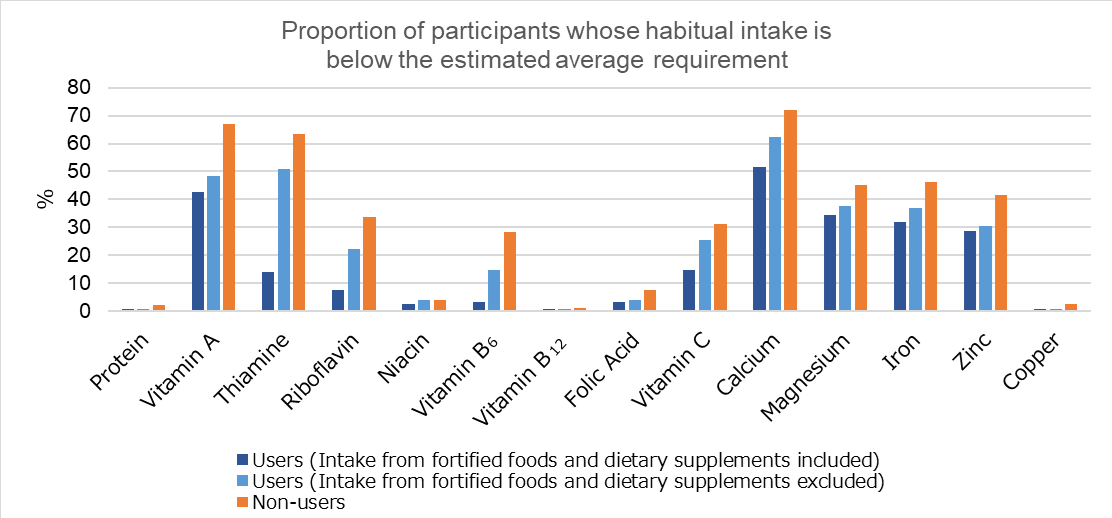October 3, 2024
How much do so-called “health foods” contribute to nutrient intake? Analysis of dietary record data of the Japanese population

The results of this study were published in the journal BMC Nutrition on September 27, 2024. The key points are as follows:
- Users of fortified foods and/or dietary supplements had a higher intake of vitamins and minerals from base diets(i.e., diets excluding fortified foods and dietary supplements) than non-users, and a higher proportion met the adequate intake levels set by dietary reference standards.
- Fortified foods and/or dietary supplements contributed to the adequate intake of certain nutrients by their users.
- However, 2% of the users of fortified foods and/or dietary supplements had a risk of excessive vitamin B6 intake.

The results of this study were published in the journal BMC Nutrition on September 27, 2024. The key points are as follows:
- Users of fortified foods and/or dietary supplements had a higher intake of vitamins and minerals from base diets(i.e., diets excluding fortified foods and dietary supplements) than non-users, and a higher proportion met the adequate intake levels set by dietary reference standards.
- Fortified foods and/or dietary supplements contributed to the adequate intake of certain nutrients by their users.
- However, 2% of the users of fortified foods and/or dietary supplements had a risk of excessive vitamin B6 intake.

Proportion of participants whose habitual intakes is below the estimated average requirement among users (n=122) and non-users (n=270) of fortified foods and/or dietary supplements.
Among 392 Japanese adults, 122 adults were classified as users if they used fortified foods or dietary supplements at least once on the four-day food record days, and otherwise were classified as non-users.
Journal:
BMC Nutrition(September 27, 2024)
Title:
Contribution of fortified foods and dietary supplements to total nutrient intakes and their adequacy in Japanese adults
Authors:
Minami Sugimoto, Keiko Asakura*, Nana Shinozaki, Kentaro Murakami, Shizuko Masayasu, Satoshi Sasaki
DOI:
10.1186/s40795-024-00935-w
BMC Nutrition(September 27, 2024)
Title:
Contribution of fortified foods and dietary supplements to total nutrient intakes and their adequacy in Japanese adults
Authors:
Minami Sugimoto, Keiko Asakura*, Nana Shinozaki, Kentaro Murakami, Shizuko Masayasu, Satoshi Sasaki
DOI:
10.1186/s40795-024-00935-w
READ MORE RESEARCH NEWS - MEDICINE
ACADEMICS
Undergraduate Programs
– Medicine
– Pharmaceutical Sciences
– Science
– Nursing
– Health Science
Graduate Programs
–Medicine
–Pharmaceutical Sciences
–Science
–Nursing
Undergraduate Programs
– Medicine
– Pharmaceutical Sciences
– Science
– Nursing
– Health Science
Graduate Programs
–Medicine
–Pharmaceutical Sciences
–Science
–Nursing
RESEARCH
– News
– Guidelines & Policies
– Support Offices
– Facilities
– Security Export Control
Non-Degree Programs
– Clinical Elective Program
– International Physician Observership Program




